“What If?”
H.G. Wells’ classic 1895 novel, The Time machine, tells of a young, ideological inventor who creates the ultimate device, a machine that allows him to break the confines of the universe and travel in the fourth dimension. With this device, the inventor (who remains unnamed and is only called the Time Traveler) narrates his voyage to the year 802,701, a time in which humanity has degenerated into two species sculpted not by God but by nature’s indifferent efficiency.
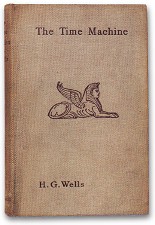
This setting in the far future is populated by the delicate and placid Eloi, descendants of the wealthy and privileged, who live in Edenic bounty and “feeble prettiness” on Earth’s surface, and by the savage Morlocks, descendants of the working class who have devolved into cannibalistic subterranean brutes feeding off the lazy, illiterate “Upper-world people.” Near the novel’s end is a beautifully rendered scene set eons later still. Here the final, gasping breath of evolution, human and otherwise, is embodied in a single tentacled creature on a beach beneath a bloated red sun at the twilight of the world. It is a scene lit by loneliness and failure and Ozymandian futility.
Wells intentionally fashioned his novel to be a commentary on the social imbalances of the time. His bleak vision was a direct attack on the ever-growing, capitalist state emerging at the end of the 1800s. In his commentaries, H.G. Wells described himself as a self-made social reformer who climbed from the brutal working-class life of poverty. With this experience, he sought to criticize the growing gaps between the nation’s rich and poor. More than 100 years later, we read a tale of great imagination and great adventure.
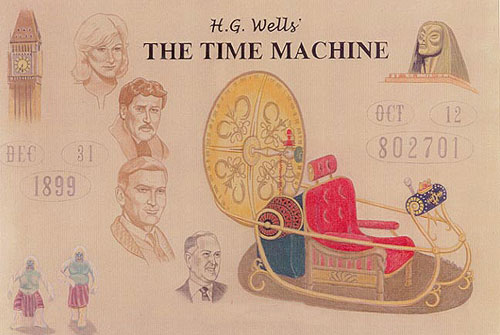
Recognizing the superb premise laid out in Well’s novel, Director George Pal translated the story into the 1960 screen classic, The Time Machine. Fortunately, he opted to maintain the Victorian setting of the film rather than attempting to update it to a contemporary setting. He started his film on New Year’s Eve in 1899, with a gathering of friends awaiting their host, George (Named after Wells, not George Pal), who is overdue. George (Rod Taylor) stumbles in, dirty and beaten, to tell a fantastic story of his journey to the far flung future, where he changed the course of a long standing struggle between two divergent races of man.
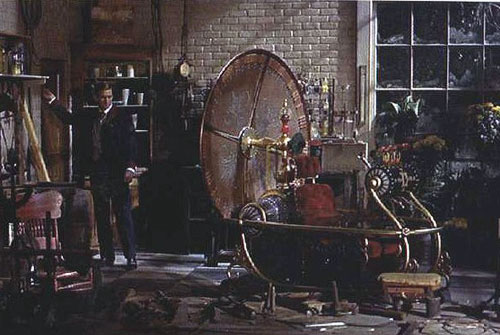
Where the novel stood directly against the growing industrial society of 19th Century America, George Pal’s film version stood directly against the horrors of nuclear war. Continuing the social protests of films like Rocketship X-M, the 1960 version of The Time Machine focuses on the damage and loss inflicted through warfare. Even the basic conflict of between the Eloi and the Morlocks is shown as an offspring of mindless war to the end.
This is most dramatically illustrated through the interactions between George and Jamie, the son of his friend who he meets during WWI and WWII. Through these contacts we learn that George’s friend, David Filby (Alan Young) followed his sense of patriotism and nationalism and dutifully marched to his death.
Soon afterwards, we are completely removed from the world as we know it and hurled into the pure fantasy environment of Wells’ 1895 vision. Nuclear weapons rain down on George’s London property, blasting away the entire city as George races away into the future. The blasts rupture the geologic structure encasing the Time Traveler in lava.
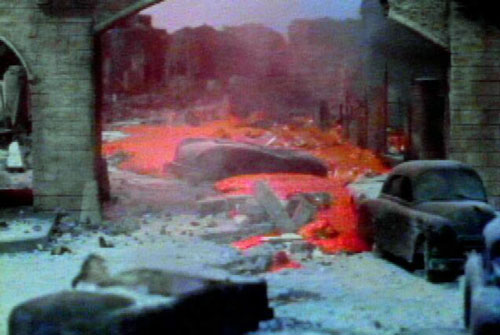
When he is free, he is in a world unlike any he has seen. It seems to be a quiet paradise, populated by beautiful and simple people, foremost of which is Weena (Yvette Mimieux), a future love interest that binds George to this new strange time. H.G. Wells didn’t have a female companion for the Time Traveler, it being unnecessary for the social-political story he was telling. George Pal knew that a successful film at that time had to have one. Since its premiere, audiences have wholeheartedly agreed with Pal.
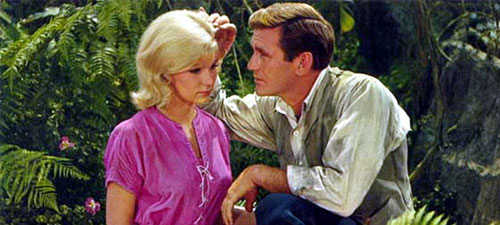
After some initial exploration, George the Time Traveler believes that he may have finally found his Utopia, a world where ambitions and conflicts have been replaced with a life of luxury and leisure. He quickly learns that the illusion is very frail. The Eloi are a people totally apathetic to the world around them, uncaring to their past and seemingly ignorant of any way to influence their future.
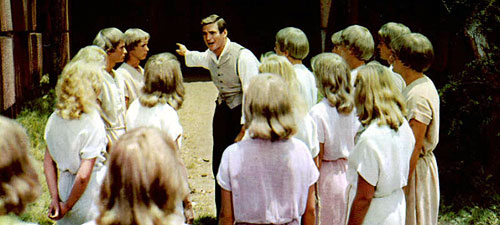
Disgusted, George intends to leave, and return to his own time. When he seeks to leave, he learns that the a race of underground dwellers called the Morlocks have stolen his machine. He seeks to get it back only to learn that there are more sinister aspects to the Morlocks. They are maintaining the Eloi as a ready food supply, having trained them to walk into their lair at the sound of blasting sirens. George discovers this danger when Weena is taken by the humanoids.
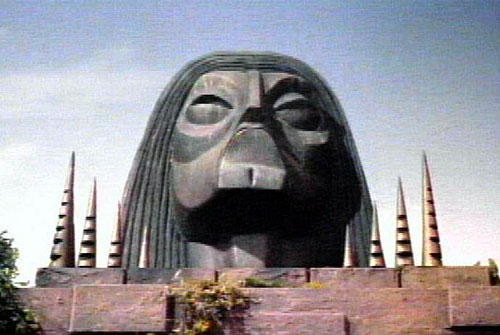
The Morlocks prove to be the descendants of that part of humanity who fled underground to survive the nuclear war. They never returned to the surface. Over 800,000 years they mutated into cannibalistic monsters who raise the Eloi like cattle, providing them food, fixing their buildings in secret, then slaughtering them. Like Well’s blue-collar workers, they are the machine builders.
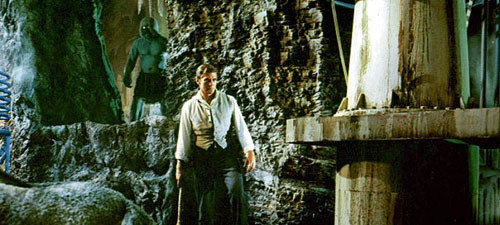
George crawls into their lair, battles them in physical combat, and rescues the imprisoned Eloi. During the escape, he sets fire to the Morlock’s cave, incinerating the mass of the humanoids. As the lair begins to burst apart from heat, he locates his machine but is then trapped and separated from Weena. Faced with death at the hands of the surviving Morlocks, he uses his machine to return to his own time.
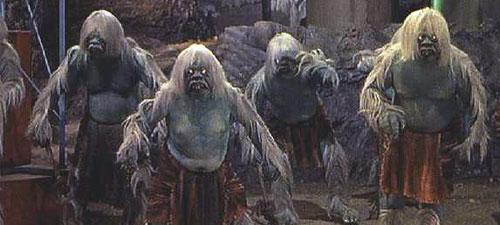
The film ends shortly after George has explained his story. He wishes Filby well, and returns to his machine. After dragging it back to the spot where he last saw Weena, he again travels to the future, taking only three books with him. The film ends asking the question, “Which three books?”
Yet, that isn’t the end of the George Pal story. The DVD release of the George Pal classic includes the 1993 featurette The Time Machine: The Journey Back, which reunites George and Filby (again played by Rod Taylor and Alan Young). This extension to the original movie shows George’s second return, just prior to Filby’s departure to fight in WWI. George explains that he lived a good, happy life with Weena before returning back to his own time. He also explains that he returned to to talk Filby out of going off to war. Frustrated, insisting that he won’t shy away from his duty, Filby leaves. George lets him go, planning to head forward in time, the day before Filby’s known death, and save his friend. It’s a nice scene and a pleasure to see the characters reunited after so many years.
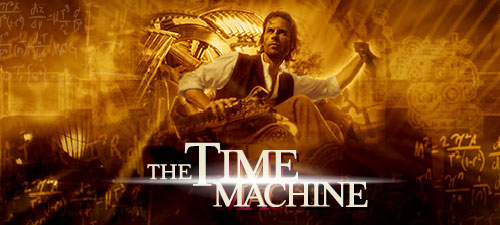
George Pal’s vision was remade in 2002. Integrating a drastically different story, with its own unique themes, this remake retained all of the key elements of both the original H.G. Wells novel and the 1960 classic film.
This remake is visually impressive and clever, centering on the Time Traveler’s inability to change tragic events of the past. Faced with this dilemma, he speeds away into the future, intent on learning the secrets of this supermythical barrier.
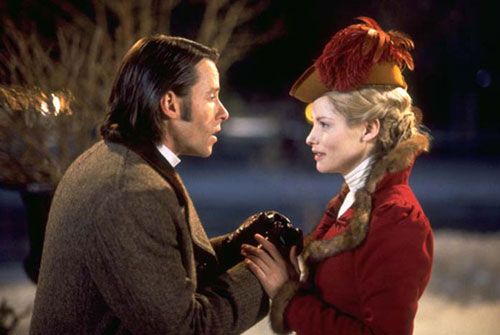
In this version, Well’s nameless Time Traveler is identified as Prof. Alexander Hartdegen (Guy Pearce), an absent-minded young scientist and professor at Columbia University in the late 19th century. His future is shattered when his beautiful fiancee, Emma (Sienna Guillory), is killed by a mugger in Central Park. Devastated by this loss, he invents a time machine in order to travel back in time and stop the tragedy. His machine works, but his scheme doesn’t. He saves her from the gunshot only to loose her on the same night to another tragedy.
He realizes that there is some fundamental law of the universe that prevents him from altering the past. Unable to comprehend this barrier with his 19th century knowledge, he forward, into the 21st century, to gain knowledge of time travel. He arrives at the New York Public Library in the year 2037.
He meets a holographic librarian, Vox (Orlando Jones), who provides a very nice tribute to H.G. Wells and the 1960 film. The encounter is entertaining for the audience but not much helpful to the professor.
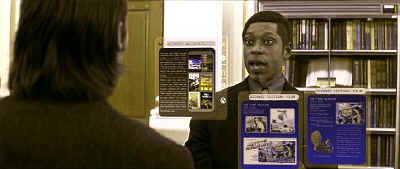
Just as he returns to his time machine, Alexander is caught in a horrific tragedy when the moon, overmined and fractured by the misuse of powerful explosives, fractures. Debris rains upon the Earth, causing catastrophic loss and setting the foundations for the rise of the Eloi and the fall of the Morlocks. The mayhem jolts the professor as he escapes in his machine, knocking him unconscious.
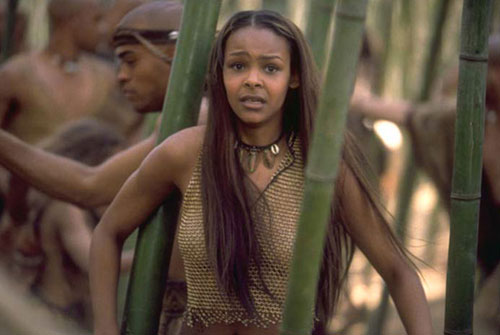
He awakens 800,000 years in the future where he is rescued and healed by a peaceful, dark-skinned human species called the Eloi, a few of which have preserved the English language, represented by Mara (Samantha Mumba) who serves as the replacement for the 1960 film’s love interest, Weena.
Alexander remains with the Eloi for a short time, before they are ambushed by Morlocks, underground dwellers who hunt and feed on the Eloi.
Alexander learns that the Eloi and Morlocks are two branches of mankind that split while the race was fighting for survival after fragments of the moon devastated the surface of the planet. The Morlocks were forever forced underground and branched into three distinct variants, each serving their own purpose. One version, serving as the scouts, were the eyes and ears of the Morlocks that identified Eloi to be harvested. A second, the brutish hunters, were the pure form of the Morlocks, and the last, a single leader, held powerful psychic abilities and controlled the rest.
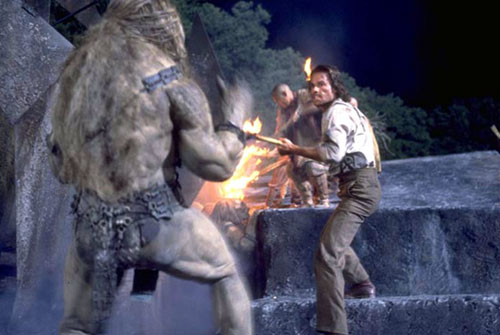
Alexander decides to rescue Mara and journeys into the Morlock’s lair. He is almost immediately captured and taken before the colonies leader, (Jeremy
Irons) who engages him in some philosophical conversation. During this, the professor learns that the Morlocks have taken his time machine and it in the hands of their leader. Alexander pleads the plight of the Eloi to no avail.
Disinterested, the leader tells the Time Traveler to return to his machine and return to his own time. Rather than follow the advice, Alexander grabs the leader and races away in time. The two battle as they are hurled further into the future. With luck rather than skill, Alexander wins the conflict and returns to rescue Mara.
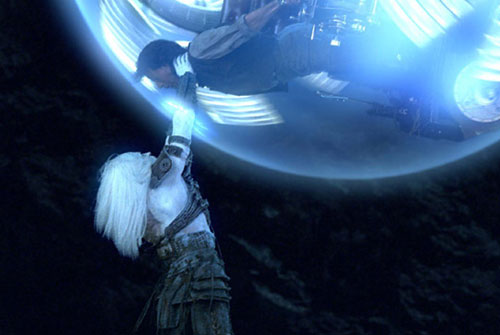
As the Morlocks begin to move in on he and his companion, Alexander jams the mechanisms of his time machine and activates it one last time. They he and his Eloi companion flee, evading Morlock brutes, and escape their underground lair. Moments later, the time machine explodes, sending a time wave hurling across the entire lair that disintegrates the underground dwellers.
Forever trapped in this new time, Alexander plans out a new life with Mara.
In all, this remake is a very good film. Directed by Simon Wells, the great-grandson of H.G. Wells, this movie gives only cursory attention to Well’s ideas of class warfare or the 1960s anti-war themes. This version is completely devoid of any social messages and its ultimate question, “What if?” is so mystic and arbitrary as to lack any real relevance.
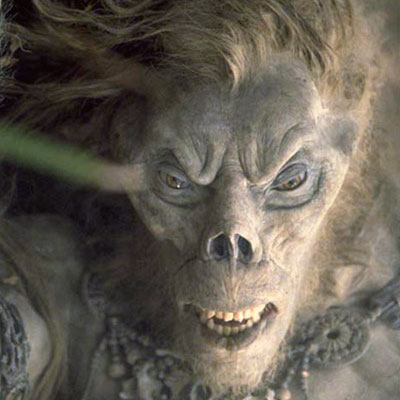
The weakest part of this movie are the Morlocks themselves. Visually, they are well done but within the context of the story, they serve only a minor role. The film does a grand job of setting up the conflict between the Eloi and the Morlocks, and specifically between Alexander an their leader, but when it actually arrives, the conflict falls flat. In some ways, it seems like the Morlocks were there because they had to be there to complete the remake, not because they were the crucial focus of the story. Their introduction scene is fairly well done but reminds you of the introduction of the gorillas in Planet of the Apes. Like the opponents in the remake of that classic, the Morlocks leap and run about overpowering humans. The parallels are obvious.
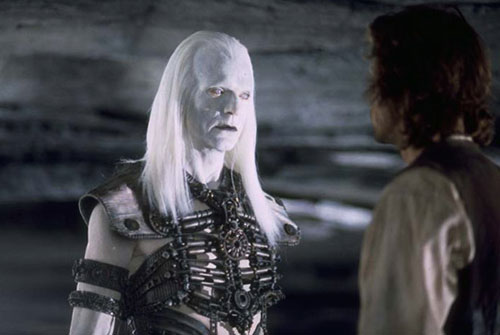
The most disappointing element of the Morlocks is the leader. These villains aren’t on the screen long enough for any viewer to be shocked or impressed that they have this leader, nor do his explanations of how the Morlocks came to be three distinct races seem to make any sense. Equally confusing are statements the leader makes indicating that Alexander himself is somehow responsible for the conditions he finds. By inference, you guess that when Alexander was first taken away by the Eloi, the leader in another form took his time machine and traveled to the past, somehow causing the damage done to the moon. This mystery is never explained, nor is there enough information to even know what the mystery really is. You get the sense that a half hour of the film was simply dropped onto the editing room floor. There seems to be a whole missing story that is critical to the climax. Consequently, Alexander’s final battle with the leader is meaningless and a bit hollow.
Despite these flaws, the 2002 The Time Machine is well worth watching. The Victorian sequences are very charming as is Alexander’s encounters in the library. The ending sequence is heartwarming and stylish. Overall, the visuals throughout the film are fairly impressive, especially the time traveling sequences.
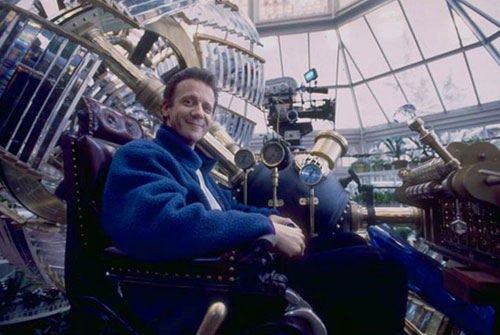
Likewise, the time machine itself is as impressive as the 1960 design. Its whirling glass blades look very Victorian and the time bubble they create are very cool, although I wondered how a 19th Century device managed to manufacture so much power and energy.
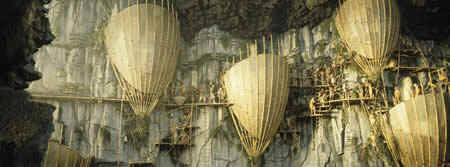
The Eloi’s village and tributes to their lost relatives are both unique and imaginative. They present a sense of independence from previous convention that is worthy of the classic film the remake is based upon. The dark lair of the Morlocks is far less impressive but serves the purpose. Compared to the other settings of the film, they are marginal.
The devastation of New York City by the moon fragments is far too short. Most of this key sequence was chopped out of the movie because the studio executives felt audiences would connect it with the terrorist events of September 11, 2001.
Probably the greatest disappointment in the movie is the quick loss of Sienna Guillory. She is absolutely superb as the ill-fated Emma. Orlando Jones also provides a very strong performance. Likewise, Jeremy Irons is chilling as the Morlock leader leaving you wondering what his character’s story actually is. His character is almost a direct copy of Michael Morcock’s Elric of Melnibonea and seems totally out of place in the movie.
Despite this hurdle, he plays the role, very, very well.
Equally impressive is the lush music by Klaus Badelt who provides his first full musical score for this film. The soundtrack isn’t as lively as his music for the 2003 “Pirates of the Caribbean”, but does give the Eloi a subtle Garden of Eden quality.
In all, the 2002 remake is well worth watching. Its seems to be an incomplete story but the parts that are there are very well done. Although it retains all of the key elements of both the 1895 novel and the 1960 classic film, the remake tells an entirely new story that is wondrous and visually appealing.
– written by the Two-Brained Cylon